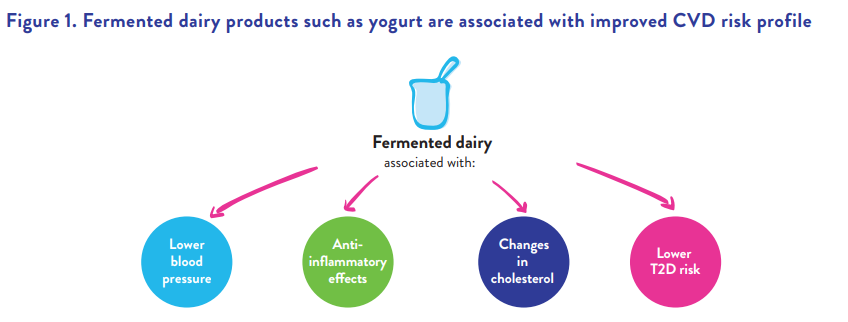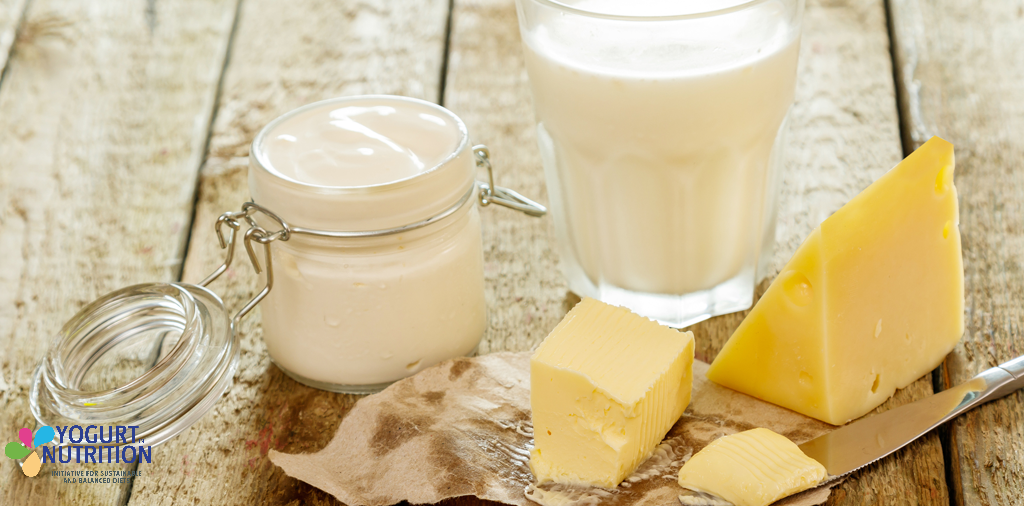Cardiovascular diseases (CVD) carry a heavy burden in terms of death and morbidity worldwide (1) and diets have a strong influence on cardiometabolic health.
For several decades, low fat foods have been promoted as part of a healthier diet to prevent the risk of CVDs, sidelining dairy products that naturally contain saturated fats (1). However, the nutritional benefits of dairy foods are now weighed against the negative perception of dairy fats.
A quick overview of lipids
Lipids form a large family including triglycerides, phospholipids, cholesterol and some fat-soluble vitamins (vitamins A, D, E and K). In everyday language, the term “fats” is used to refer to the lipids contained in foods. Lipids are made up of fatty acids, the latter classified in three biochemical groups:
- saturated fatty acids,
- monounsaturated fatty acids
- polyunsaturated fatty acids (PUFAs), which are said to be ʺessential” (omega 6 and 3) because our body does not know how to synthesize them or cannot synthesize their precursors. Thus, the diet constitutes an important source of these essential lipids.
Which are the dairy fats?
All dairy products, when they are not low-fat formulas (whole milk, plain yogurt, fresh or aged cheese) contain fat. On average, a plain yogurt (125 g) contains about 4% of lipids (~5 g of lipids), of which:
- 69% of saturated fats (palmitic, myristic, lauric, butyric, stearic acids),
- 28% of monounsaturated fats (oleic acid),
- and 3% polyunsaturated fats (linoleic and linolenic acids) (2).
The fatty acid composition varies considerably among species and breeds of dairy animals, as well as the feed (2). For example, experiments show that the milk of cows fed with grass and flaxseed is less rich in palmitic acid and richer in alpha-linolenic acids.
Which links between CVDs and dairy saturated fats?
Dairy products contribute to the lipid intake. As seen before, in particular, they bring saturated fatty acids (SFAs) and specifically palmitic, lauric and myristic acids, which are generally seen as having a negative impact on health, and would promote the development of cardiovascular risk factors (hypertension, inflammation,…) (3).
However, dairy fat is one of the most controversial components of dairy products (4), Among the several studies and metanalyses, no association between fats from dairy consumption and increased risk of cardiovascular disease has been found.
A 2021-cohort prospective study aimed to investigate the associations between dairy consumption and CVD risk in a large cohort of French adults (13). Total dairy, milk, cheese, yogurts, fermented (cheese, curd cheese, yogurts, fermented milks) and reduced-fat dairy intakes were investigated, using 24-hours dietary records. There were no significant associations between dairy intakes and total CVD risks. However, the consumption of at least 160 g/d of fermented dairy such as cheese and yogurts was associated with a reduced risk of cerebrovascular diseases compared with intakes below 57 g/d (hazard ratio = 0·81 (95 % CI 0·66, 0·98), Ptrend = 0·01).
In addition, a recent meta-analysis suggests that butter consumption, a dairy product often singled out for its high SFA content, is not associated with CVD risk and stroke (14).
Focus on the dairy fats of yogurt
With a quite low-fat content, plain yogurts stand out as a nutritionally dense food associated with lower CVDs risks (7).
In a recent study conducted in Brazil (8), a higher consumption of yogurt (> 1 serving/day versus no intake) was associated with a lower risk of cardiovascular events and death due to strokes. Yogurt is also being associated with other health benefits on the prevention of diseases such as diabetes (9) and obesity (10).
The difference between expected negative effects of saturated fats and reality may be partially explained by the complexity of the dairy food matrix. Saturated fatty acids are consumed in association with minerals, proteins, ferments. The dairy matrix may contribute to the beneficial effects of yogurt and determine the fat bioavailability (11).

Researchers agree that consumers should continue to consume full-fat dairy products in moderation as part of a healthy, balanced lifestyle, with fermented dairy products such as yogurt preferred for optimal nutrient intake and potential cardiovascular health benefits (12).
Related posts:
- Saturated fatty acids from dairy: an exception for cardiovascular health?
- Low fat dairy products and yogurt lower the risk of hypertension
- Yogurt among dietary-priorities for cardiometabolic health
- Whole dairy matrix matters more than single nutrients
- Is there an incidence of dairy foods on diabetes and mortality?
References:
- Kristin M Hirahatake, et al. Dairy Foods and Dairy Fats: New Perspectives on Pathways Implicated in Cardiometabolic Health, Advances in Nutrition, March 2020, 11 (2): 266–279
- Jensen, R. G. (2002). The composition of bovine milk lipids: January 1995 to December 2000. Journal of dairy science, 85(2), 295-350.
- Hooper L, Summerbell CD, Thompson R, Sills D, Roberts FG, Moore HJ, et al. Reduced or modified dietary fat for preventing cardiovascular disease. The Cochrane Library. 2012.
- Soltani S, Vafa M. The dairy fat paradox: Whole dairy products may be healthier than we thought. Med J Islam Repub Iran. 2017 Dec 18;31:110.
- Astrup A. et al, Saturated Fats and Health: A Reassessment and Proposal for Food-Based Recommendations : JACC State-of-the-Art Review. (2020). Journal of the American College of Cardiology, 844‑857.
- Lordan R, Tsoupras A, Mitra B, Zabetakis I. Dairy Fats and Cardiovascular Disease: Do We Really Need to be Concerned? Foods. 2018 Mar 1;7(3):29.
- Citta A, Folda A, Scalcon V, et al. Oxidative changes in lipids, proteins, and antioxidants in yogurt during the shelf life. Food Sci Nutr. 2017;5:1079–1087.
- Silva, F. M., Giatti, L., Diniz, M., Brant, L., & Barreto, S. M. Dairy product consumption reduces cardiovascular mortality: results after 8 year follow-up of ELSA-Brasil. European journal of nutrition, 2022, 61(2), 859–869
- Gijsbers L., Ding E.L., Malik V.S., de Goede J., Geleijnse J.M., Soedamah-Muthu S.S. Consumption of dairy foods and diabetes incidence: A dose-response meta-analysis of observational studies. Am. J. Clin. Nutr. 2016;103:1111–1124.
- Lordan R., Zabetakis I. Invited review: The anti-inflammatory properties of dairy lipids. J. Dairy Sci. 2017;100:4197–4212.
- Kongerslev Thorning T. et al. Whole dairy matrix or single nutrients in assessment of health effects: current evidence and knowledge gaps. American Journal of Clinical Nutrition. First published ahead of print April 12, 2017.
- Adolfsson O, Meydani SN, Russell RM. Yogurt and gut function. Am J Clin Nutr 2004;80(2):245-56
- Sellem L, et al. Consumption of dairy products and CVD risk: results from the French prospective cohort NutriNet-Santé. Br J Nutr. 2022 Mar 14;127(5):752-762.
- Pimpin L, Wu JH, Haskelberg H, Del Gobbo L, Mozaffarian D. Is Butter Back? A Systematic Review and Meta-Analysis of Butter Consumption and Risk of Cardiovascular Disease, Diabetes, and Total Mortality. PLoS One. 2016 Jun 29;11(6):e0158118.



